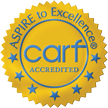Harm reduction therapy aims to minimize the harmful effects of addictive behaviors. The focus is not on the prevention of substance use itself but the prevention of harm caused by the substances in question.
We understand that you have unique challenges and difficulties, so instead of forcing you to abstain, we use a range of therapies to reduce the detrimental health and social effects that drugs and alcohol can cause.
Harm reduction strategies strive to safely promote independence rather than pass judgment or coerce unwanted change. Our harm reduction therapies are based on the Four Pillars:
- Prevention
- Harm Reduction
- Treatment/Recovery
- Community Safety
As such, our initiatives range from education, resources, medical care and disease prevention, and addiction treatment.

What Is Harm Reduction Therapy?
Historically harm reduction methods in America have been pivotal in the development of pioneering substance use treatment methods. Harm reduction first gained recognition in the 1980s with the prevalence of acquired immunodeficiency syndrome (AIDS). Implementing these strategies was important not only for substance use but also to reduce the transmission of infection. It was during the 1980s that life-saving syringe exchange programs gained popularity at both the state and local levels in the USA. Harm reduction methods additionally proved successful in treating drug disorders such as opiate use disorder with methadone and buprenorphine.
There are two primary goals for this type of therapy:
- Minimize potential harm from substances while not judging or challenging a person’s right to use drugs and alcohol.
- Provide resources, guidance, and support when a person decides to abstain.

Numerous studies have evidenced that harm reduction practices, including safe injection sites, are associated with decreased infections, fewer ambulance calls or hospital admissions for overdose, and lower overdose mortality.
However, there has been significant controversy around this form of therapy with political and social resistance to any program which could be interpreted as condoning drug use. At United Recovery CA, we understand that abstinence is not an option for everyone and rather than turn anyone away who is seeking help, we strive to provide care and support in whatever way possible.
The Principles of Harm Reduction
We understand that entering recovery can be a daunting concept. Perhaps change seems intolerable, or perhaps it is not even something you strive for. MET will support you while exploring these feelings and uncovering the root causes of resistance to change. There are five critical elements of change within the MET structure that clients and therapists work through together:
The core belief behind the harm reduction approach is to respect the individual rights of substance users. At United Recovery CA, our treatment offerings are based upon the following principles.
- Treating everyone with compassion and respect
- Use of evidence-based techniques, policies, and practices
- Avoiding and abating stigma and negative perceptions of substance users
- Minimizing the risk of harm associated with drugs and alcohol
- Focus on quality of life over abstinence
- Empowering the individual to make a change when ready
- Providing resources and access to services when people are ready to stop using substances
Do You Need Help?
We offer initial assessment and advice via phone or contact form.
Harm Reduction in Treating Substance Use Disorder & Addiction
Harm reduction practices for substance use disorder and addiction focus on avoiding overdose, fatality, risk of infection, and the development of stronger addictions.
Some effective harm reduction treatments include:
- Motivational Interviewing – Here, we use directive, non-judgmental techniques to help you explore the reasons for substance use and why you might want to change or reduce your habits.
- Moderation Management – This approach focuses on the reduction and moderation of the substance in question. It is most commonly used to reduce alcohol consumption but can be applied to other drugs. The goal is to reduce ingestion to a safe level. This therapy does not rule out drinking or demand abstinence but works with you to find ways to reduce risk.
- Opioid Replacement Therapy – This involves clinically replacing a potentially lethal opioid such as heroin with less addictive and safer alternatives, such as methadone or Suboxone.
- Safe Injection Sites – These are places where people can use substances under supervision. This reduces the risk of a fatal overdose and allows for immediate medical attention to be provided if necessary. One study recorded 67% fewer ambulance calls and a 35% decrease in mortality.
- Needle Exchange Programs – Here you can exchange potentially contaminated syringes for sterile ones. This is usually operated on a one-by-one basis and reduces the risk of blood-borne infections such as Hepatitis C and AIDS.
Harm Reduction in People with Addiction and Co-occurring Disorders
Reducing and abstaining from drug use is just one part of the recovery process. We understand that by the time you seek treatment, addiction has likely posed serious consequences in your life. You may have experienced health complications, relationship breakdowns, loss of employment, and maybe even taken part in criminal activity.
It is therefore common for those suffering from addiction to experience co-occurring disorders such as depression, anxiety, trauma disorders, and eating disorders. Additionally, while decreasing or abstaining from substance use, other addictions may emerge, such as sex, gambling, shopping, or food.

Harm reduction therapies focus not only on the substance itself but also on the surrounding mental health conditions. Through our person-centered approach, we may promote a range of other harm reduction practices such as supplying clean razors to those who self-harm, encouraging safe sex, focusing on healthy food instead of binge eating, providing exercise advice, and offering counseling services to help you find the confidence to work through these issues. Every meaningful change counts and is vital in the effort to decrease harm and minimize risk.
The Dos and Don’ts of Therapy
DOs
- Be as open as possible. Even though it might feel impossible to open up, the more you share, the more you can be helped.
- Give feedback, but be sensitive about your approach. Be specific, but also be kind.
- Listen to feedback.
DON’Ts
- not asking questions.
- Over-prepare and rehearse, which can lead you to rely too much on stories that have the desired outcome. Rather than be authentic, be aware of the dynamics of the sessions and share accordingly.
Harm Reduction Therapy – The (United Recovery CA) Approach
At United Recovery CA we are proud to incorporate evidence-based treatments and techniques into our personalized, person-centered approach.
As Johann Hari famously quoted, “The opposite of addiction is connection.”
We understand that addiction affects all aspects of a person’s life including relationships between families, friends, employers, and co-workers.
A vital part of our harm-reduction therapy is to assist the client with building an honest, transparent, and positive rapport with those who seek to support them. This includes family and one-to-one sessions among other methods.
Additionally, we have uniquely tailored treatment plans for professionals and for LGBTQ+, men, and women, as we recognize that each group of individuals has unique challenges and obstacles to overcome. We are here for you, ready to support you throughout the way. This will be a challenging endeavor, but we can achieve success if we work together!

Meet your recovery team
The recovery journey is unique and personal to everyone. Our team are highly trained professionals who set United Recovery CA apart due to their expertize, and each staff member brings their unique knowledge and experience to addiction treatment. They provide a safe environment to provide the ideal start of your addiction recovery.






